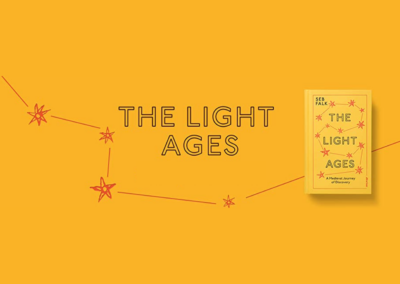
December 3. First Sunday of Advent: Nature also is Waiting, Anticipating and Groaning in Expectation
Advent participates in the Church’s life of waiting and anticipating. In this case waiting for the deepest mystery of our life together, the coming of God amongst us — Christmas, or the coming of the Christ as a baby. This is the first of four blogs looking at science themes of anticipation that resonate with our Advent season.
The first Sunday is traditionally that of the Patriarchs. And indeed the whole of the Old Testament is a story of anticipation of a messiah. We hear of the Suffering Servant, of a time of fulfilment, the outworkings of the covenant the Jews made with God, and all of these yearnings were mixed with their desire for a political answer to their plight of exile.
In the Nature and Destiny of Man, based on the Gifford Lectures given in 1939 as war was breaking out in Europe, Reinhold Niebuhr talked about whether our religious stories “expect a Christ” or don’t expect a Christ. He noted that the Abrahamic religions all expect a messiah. They are stories/religions of hope. He had a point, and one that is important at this time. Christmas is not the beginning of our Christ story; rather we see anticipations of this deep in the Hebrew Bible. We often think though, that nature is neutral, not in the business of anticipation. And yet the natural world helps us to believe.
Imagine lying on a blanket on a Spring day, trees overhead and a river flowing beside us, with the sounds of life buzzing and chirping. Trees, animals, insects and water all combine to calm us, to surround us and give us a sense of nature’s embrace of us; and all around the striving of life, and the purposefulness of water and creature imbue in us a sense of hope. Science also opens up the vastness of the world of nature. So that even in a telescope or a lab the natural world meets halfway, and discloses almost infinite depth. These experiences reveal what we can call the inner life of nature, its deep striving, its sense of purpose, its interconnectedness, depth and responsiveness.
The Bible, for instance, says:
The heavens proclaim the glory of God –psalm 19
You will go forth in joy, and be led forth in praise
The trees of the field will clap their hands –Isaiah 55:12
We know that the whole creation groans and labours with birth pangs together until now. – Romans 8
These passages among many many others also point to the inwardness of nature and to its sense of anticipation.
Anticipation, I would argue, is inevitably entangled with watching, participating in and relating to the processes and agents in nature, whether by lying in the sun, battling the elements, watching the light at dusk, or delving into scientific mysteries. Hope begins as we come to terms with human life as deeply interconnected, as being emergent, like all nature, in unpredictable ways from within previous life or matter.
Philosophers have also tried to describe the anticipation in nature, and its associated hints of glory. David Abram, for instance speaks to the inwardness of the passages above. Both phenomenology and evolutionary theory show us we need to heed the long long pre-history of humanity. In this long history, cells, mitochondria, fungi, molecules and intricate neurobiological networks undergird and make life and consciousness possible. Language and all higher intellectual powers have their origins and prototypes in earlier forms of life. Humans are deeply embedded creatures, sharing in a multiplicity of kindred life and matter. When hope is funded by these deeper levels of being it is more robust.
Abram says,
The experience of depth is not created in the brain any more than it is posited by the mind. . . . [W]e can discover depth, can focus it or change our focus within it only because it is already there, because perception unfolds into depth — because my brain, like the rest of my body, is already enveloped in a world that stretches out beyond my grasp.
In the Western Tradition human language was commonly thought to be an emancipation from the animal natures of the “sixth” day of creation. In contrast, Abram recognizes that we respond to the forms and inwardness of nature, and consciously or unconsciously these responses shape our thinking, even or especially, thinking of transcendent and spiritual things. Although Abram based his philosophy on earlier science, phenomenology does cohere with our present evolutionary thinking which understands that language and symbolic thought, however and whenever they emerged, did so gradually as the extension of our animal cognitive abilities as they were shaped by the social domain of our tribal existence.
This is radical, and has far-reaching repercussions. Our creativity and its most abstract conceptions, begin not only with some transcendent outside connection with God, but also with the depth of the living world within which we reside. And God is never far from this world. From a theological point of view, of course, this means that all nature — within which God was and is incarnate and all of which originates in God — speaks to us first. Its interior life, its fractal like tributaries, its concealed formal causes are the beginning of our communicative magic. When we think we are being most transcendent (in mathematics, for instance) most emancipated, we are really most embodied. Nature informs us of depth and patterns. This realization also connects us to the animal world. For they too are perceiving nature along these same lines, but without the leap to symbolic language. They inhabit the same intersubjective space; but their whole apparatus of communal life occurs outside the kind of conscious self-reflection and recursion humans experience and express.
All of this has a bearing on the Incarnation. Sometimes in the past this has been understood as a drama involving just our religious heroes of the past, God and humans. It is easy to forget that Jesus was born in a stable. We can now understand the incarnation more deeply. For one, Jesus in becoming human also shares with all life. He has come to be “in us”, and we are “in” the world. For another, the basic stance of expectation that we celebrate in Advent can also be discerned within the depths and creativity of the natural world. This resonance should be deeply encouraging. Next week I will look at anticipation within the evolutionary process.
Bibliographic Notes
For a longer version of this blog see my chapter, “ The Phenomenology of Hope” in an edited book, Creation and Hope (Wipf & Stock, 2018), edited by me and Andrew Shepherd.
For more about Deep Incarnation, see “Deep Incarnation and the Cosmos: A Conversation with Niels Gregerson,” ASA, Summer, 2017.
For a prolonged discussion of religions that expect a Christ see Reinhold Niebuhr, The Nature and Destiny of Man, (2 vols, 1943)
For work by David Abram see, David Abram, “Merleau-Ponty and the Voice of the Earth,” in Minding Nature: The Philosophy of Ecology, ed. David Macauley (OUP, 2014).
DECEMBER 10 Second Sunday of Advent: The Anticipatory Aspects of Evolution
God’s activity is present, though hidden, a power which expresses itself at particular points according to laws which, if hidden from us, are nevertheless of divine arrangement.” (Schleiermacher, Christian Faith, §13)
Last week I wrote about nature as having depth and beauty, as having an inherent sense of anticipation or purpose, a face. This week, the second week of Advent I will look more deeply at newer understandings of the evolutionary process. I will argue that prophets and viruses have much in common; they “see” the future.
Evolution as anticipating a future omega point in Christ was always the overall theme of the twentieth-century theologian Teilhard De Chardin, but the sheer materiality of evolutionary understanding in the second part of the twentieth century eclipsed the Frenchman’s work, though process theology always maintained some idea of the lure/love of God in creation.
The twenty-first century, however, is beginning to be different. In his 2004 book, Life’s Purpose, for instance, Simon Conway Morris said quite presciently:
The heart of the problem…is to explain how it might be that we, a product of evolution, possess an overwhelming sense of purpose and moral identity yet arose by processes that were seemingly without meaning. If, however, we can begin to demonstrate that organic evolution contains deeper structures and potentialities, if not inevitabilities, then perhaps we can begin to move away from the dreary materialism of much current thinking with its agenda of a world now open to limitless manipulation. (2004, 2)
Conway Morris is an expert in convergent evolution, the idea that evolution comes up with the same “solutions” over and over again. Which is interesting. There are now many articles and books looking at this different perspective on evolution. See for instance, this essay by James Shapiro in Aeon Magazine, and in terms of books, see Denis Noble, The Dance of Life. We now know that Darwin over-emphasized competition in nature and underemphasized the deep synergies and cooperation at every level. Nowhere is that cooperation more evident than it is in the co-evolution of viruses and other life forms, mammals in particular.
We now think that at least 50% of human DNA is viral in its origins. We are all aware of the destructive power of viruses, but they are not just an enemy. Viral inserts into the germ-line have changed human and other genomes again and again in adaptive ways. Viruses, even more than changing environments, might be the reason evolution happens.
Really interesting also is the evolutionary idea of co-option. Evolution harnesses previous building blocks and DNA segments and puts them to new uses. It also uses viral insertions to good purpose. Supposedly these “insertions” are completely random. In everyday life or in a courts of law, if random happenings resulted in an organ crucial to life for all mammals one would have to say that something strange is going on. The hidden constraints that make all of this possible are staggering.
So, the work of our previous co-director Graeme Finlay is interesting in bringing our attention to the evolution of the placenta. The placenta, of course, is an organ that is crucial to new life and to birth. For Māori the word for placenta (whenua), is also the word for land. Birth is such an extraordinary image, of new life and hope, and Jesus we know began life in Mary’s placenta which was the result of several happy “accidents” of evolutionary history.
Graeme explains how the placenta arose during mammalian evolution, which in his words:
is recent in evolutionary terms. Genetic changes underlying placental development remain identifiable by the new science of comparative genomics (approximately post-2000). Randomly arising features of genomes including endogenous retroviruses and transposable elements have provided structural genes and gene-regulatory motifs responsible for innovations in placental biology. Stochastic geneticevents indeed contribute to new functionality
He goes on to says that parasitic units of genetic material
Retroviruses and transposable elements (TEs) are genome-disrupting agents that have contributed to the evolutionary development of the placenta, and so provide an illuminating demonstration of evolutionary descent and the generation of innovation.
Thus, evolution occurs partially by the inclusion of certain “foreign” retroviral elements and TEs, which become adopted and co-opted by the host organism, and partly by the duplication or transposition of existing genetic material.
That means that without these unscheduled and potentially disruptive processes, humans would not have their distinguishing organ of reproduction, the placenta, in its current form.
In particular, Graeme talks about a viral insert with the name ERVW-1. The envelope of this viral insert is sticky and “has been domesticated (or co-opted) to specify a protein that serves human reproduction.” This allows cells called “cytotrophoblasts to stick together and fuse into a layer, the syncytiotrophoblast, which forms the critically important interface between fetal and maternal placental tissues.” The repurposed envelope protein has been renamed syncytin-1.
But that is not all. Other viral inserts named ERVFRD-1 has been coopted to produce syncytin-2 and INSL4 produces insulin-related proteins. And one more,
Placental syncytiotrophoblast tissue of anthropoid primates (but not of other species) produces corticotropin-releasing hormone (CRH) in late pregnancy. Placental CRH contributes to the timing of parturition.
This is astonishing. One can see why some people look at all of this and point to a designer. There is no evidence, however, of a heavy-handed designer playing with the clay of creation; rather the creator acts in a more subtle way, within processes and constraints that are inherently creative and anticipatory. We don’t know how. We might never know how, because biology is fast becoming as deep as physics. But the anticipatory nature of evolution can give us a deep peace about affirming that there is a Creator. And it is particularly marvellous that the incarnation “uses” the most extraordinary example of evolution we have yet discovered, and that viruses are a part of the anticipation of nature in evolution.
Bibliographic Notes
The Amazing Placenta, Zygon, vol. 55, no. 2 (June 2020)]
Jams Shapiro, Evolution without accidents, Aeon, Magazine
Denis Noble The Dance to the Tune of Life (CUP, 2016)
Simon Conway Morris, Life’s Solution (CUP, 2004)
DECEMBER 17 Third Sunday of Advent: Teilhard de Chardin
Teilhard de Chardin was a French Jesuit priest and paleontologist, born in 1881 He worked much of his life in exile in China, which he found fascinating. He had some association with the infamous Peking Man. But he was one of the first theologians/scientists to envision a synthesis of evolutionary biology and sacred history together. It helped that in many ways he was unfamiliar with the minutiae of evolutionary biology in the early twentieth century because the purposefulness he envisaged in evolution was anathema to most of biology at the time. He believed that evolution was progressing toward an Omega Point in Christ. He was working and writing at a time when conservative popes were reigning at the Vatican, and he was never given permission to publish his profound works during his lifetime. They include the very famous, The Phenomenon of Man (published in English in 59) and Le Milieu Divin (60).
The third Sunday in Lent is the Sunday of John the Baptist, the forerunner of Christ. And in some ways, these figures repeat themselves in history. Teilhard de Chardin is an early forerunner of a synthesis in biology and theology that is now becoming more common. Though in the late twentieth century it was also represented in process theology which understood the lure of God operating in each instant of time in the world, luring the creature, the object, the atom towards a future in God. In this series, we are looking at the theme of anticipation and purpose in science as a kind of reflection of the anticipatory themes of this season.
That Chardin’s work was banned during his lifetime made his work all the more popular after his death. He died as he had wanted on Easter Sunday, 1955.
His work then burst onto the scene and was widely translated in the 1960s, coinciding with the great changes in the Catholic Church of Vatican II. Teilhard de Chardin was also a forerunner, a prophetic voice on the edges of the twentieth century. So I have included here some pertinent quotes from Teilhard de Chardin:
“Love is the most universal, the most tremendous and the most mystical of cosmic forces. Love is the primal and universal psychic energy. Love is a sacred reserve of energy; it is like the blood of spiritual evolution.”
(The Spirit of the Earth, 1931, VI, 32, 33, 34)
“The day will come when, after harnessing space, the winds, the tides, and gravitation, we shall harness for God the energies of love. And on that day, for the second time in the history of the world, we shall have discovered fire.”
(“The Evolution of Chastity,” in Toward the Future, 1936, XI, 86-87)
“The farther and more deeply we penetrate into matter, by means of increasingly powerful methods, the more we are confounded by the interdependence of its parts,
(The Phenomenon of Man)
And Jane Goodall on Teilhard de Chardin:
“There are really only two ways, it seems to me, in which we can think about our existence here on Earth. We either agree with Macbeth that life is nothing more than a ‘tale told by an idiot,’ a purposeless emergence of life-forms including the clever, greedy, selfish, and unfortunate species that we call homo sapiens – the ‘evolutionary goof.’ Or we believe that, as Pierre Teilhard de Chardin put it, ‘There is something afoot in the universe, something that looks like gestation and birth.’ In other words, a plan, a purpose to it all.”
(Jane Goodall, Reason for Hope: A Spiritual Journey. New York: Warner Books, 1999: xi-xii.)
Bibliographic Resources



